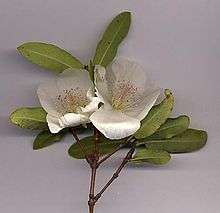Cunoniaceae
Cunoniaceae is a family of 27 genera and about 300 species[3] of woody plants in the order Oxalidales, mostly found in the tropical and wet temperate regions of the Southern Hemisphere. The greatest diversity of genera are in Australia and Tasmania (15 genera), New Guinea (9 genera), and New Caledonia (7 genera). The family is also present in Central America, South America, the Caribbean, Malesia, the island of the South Pacific, Madagascar and surrounding islands. the family is absent from mainland Asia except from Peninsular Malaysia, and almost absent from mainland Africa apart from two species from Southern Africa (Cunonia capensis, Platylophus trifoliatus). Several of the genera have remarkable disjunct ranges, found on more than one continent, e.g. Cunonia (Southern Africa & New Caledonia), Eucryphia (Australia & South America) Weinmannia sect. Weinmannia (America and the Mascarenes).
| Cunoniaceae | |
|---|---|
 | |
| Eucryphia in flower | |
| Scientific classification | |
| Kingdom: | Plantae |
| Clade: | Tracheophytes |
| Clade: | Angiosperms |
| Clade: | Eudicots |
| Clade: | Rosids |
| Order: | Oxalidales |
| Family: | Cunoniaceae R.Br.[2] |
| Genera | |
|
Ackama | |
| Synonyms | |
| |
The family includes trees and shrubs; most are evergreen but a few are deciduous. The leaves are opposite or whorled (alternate in Davidsonia), and simple or compound (pinnate or palmate), with entire or toothed margin, and often with conspicuous stipules (interpetiolar or intrapetiolar). The flowers have four or five (rarely three or up to ten) sepals and petals. The fruit is usually a woody capsule or a follicle containing several small seeds.
The family has a rich fossil record in Australia[4] and fossil representatives are known in the Northern Hemisphere. Platydiscus peltatus was found in Upper Cretaceous rocks from Sweden and is likely a member of the Cunoniaceae.[5] An earlier possible fossil member is from the Cenomanian. Tropidogyne, found in Burmese amber, has flowers that strongly resemble the extant Ceratopetalum.[6]
Classification[7][3]
|
Tribe Spiraeanthemeae
Tribe Schizomerieae
Tribe Geissoieae
Tribe Caldcluvieae
Tribe Codieae Tribe Cunonieae
|
Unplaced to tribe
|
References
| Wikimedia Commons has media related to Cunoniaceae. |
| Wikispecies has information related to Cunoniaceae |
- Peter F. Stevens. "Cunoniaceae". APWeb.
- Angiosperm Phylogeny Group (2009). "An update of the Angiosperm Phylogeny Group classification for the orders and families of flowering plants: APG III". Botanical Journal of the Linnean Society. 161 (2): 105–121. doi:10.1111/j.1095-8339.2009.00996.x.
- Bradford, J.C., Hopkins, H.CF., Barnes, R.W . (2004). Cunoniaceae. in Kubitzki, K. (ed.) The Families and Genera of Vascular Plants: Volume VI, Flowering plants, Dicotyledons: Celastrales, Oxalidales, Rosales, Cornales. Springer, Heidelberg. p 91-111.
- Barnes, R.W., Hill, R.S., & Bradford, J. C. (2001) The history of Cunoniaceae in Australia from macrofossil evidence. Australian Journal of Botany 49 : 301‑20.
- Schönenberger, J., Friis, E.M., Matthews, M.L., et Endress, P.K. (2001). Cunoniaceae in the Cretaceous of Europe: evidence from fossil flowers. Annals of Botany 88 : 423‑37.
- Chambers, K.L., Poinar, G., et Buckley, R. (2010). Tropidogyne a new genus of early Cretaceous Eudicots (Angiospermae) from Burmese amber. Novon 20 : 23‑29.
- Bradford, J.C. & Barnes, R.W. (2001). Phylogenetics and classification of Cunoniaceae (Oxalidales) using chloroplast DNA sequences and morphology. Systematic Botany 26 (2): 354‑85.